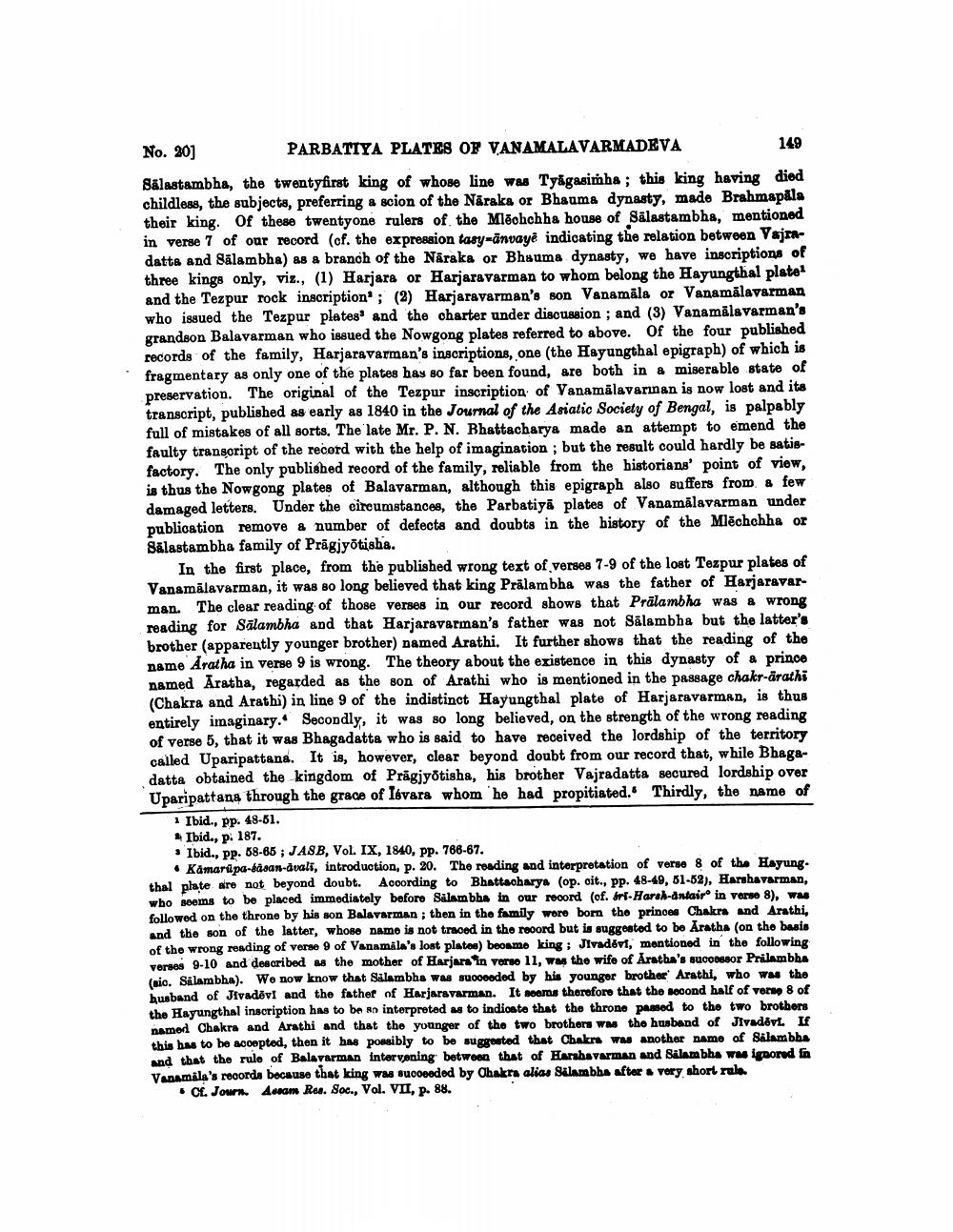________________
149
No. 20)
PARBATIYA PLATES OF VANAMALAVARMADEVA Salastambha, the twentyfirst king of whose line was Tyagasimha; this king having died childless, the subjects, preferring a scion of the Näraks or Bhauma dynasty, made Brahmapala their king. Of these twentyone rulers of the Mlēohchha house of Sälastambha, mentioned in verse 7 of our record (cf. the expression tasy=ānvaye indicating the relation between Vajradatts and Salambha) as a branch of the Näraka or Bhauma dynasty, we have inscriptions of three kings only, viz., (1) Harjara or Harjaravarman to whom belong the Hayungthal plate and the Tezpur rock inscription'; (2) Harjaravarman's son Vanamāla or Vanamālavarman who isgued the Tezpur plates and the charter under discussion; and (3) Vanamālavarman's grandson Balavarman who issued the Nowgong plates referred to above. Of the four published records of the family, Harjaravarman's inscriptions, one (the Hayungthal epigraph) of which is fragmentary as only one of the plates has so far been found, are both in a miserable state of preservation. The original of the Tezpur inscription of Vanamälavarinan is now lost and its transcript, published as early as 1840 in the Journal of the Asiatic Society of Bengal, is palpably full of mistakes of all sorts. The late Mr. P. N. Bhattacharya made an attempt to emend the faulty transcript of the record with the help of imagination ; but the result could hardly be satisfactory. The only published record of the family, reliable from the historians' point of view, is thus the Nowgong plates of Balavarman, although this epigraph also suffers from a few damaged letters. Under the circumstances, the Parbatiya plates of Vanamälavarman under publication remove a number of defects and doubts in the history of the Mlēchchha or Salastambha family of Prāgjyotisha.
In the first place, from the published wrong text of verses 7-9 of the lost Tezpur plates of Vanamālavarman, it was so long believed that king Prälambha was the father of Harjaravar man. The clear reading of those verses in our record shows that Prālambha was & wrong reading for Salambha and that Harjaravarman's father was not Sälsmbha but the latter's brother (apparently younger brother) named Arathi. It further shows that the reading of the name Aratha in verse 9 is wrong. The theory about the existence in this dynasty of a prince named Aratha, regarded as the son of Arathi who is mentioned in the passage chakr-arathi (Chakra and Arathi) in line 9 of the indistinct Hayungthal plate of Harjaravarman, is thus entirely imaginary. Secondly, it was so long believed, on the strength of the wrong reading of verse 5, that it was Bhagadatta who is said to have received the lordship of the territory called Uparipattana. It is, however, clear beyond doubt from our record that, while Bhagadatta obtained the kingdom of Prāgjyotisha, his brother Vajradatta secured lordship over Uparipattana through the grace of Isvars whom he had propitiated. Thirdly, the name of
1 Ibid., pp. 48-51. 4 Ibid., p. 187. 3 Ibid., pp. 58-65; JASB, Vol. IX, 1840, pp. 766-67.
•Kamaripa-basan-duals, introduction, p. 20. The reading and interpretation of verse 8 of the Hayung. thal plate are not beyond doubt. Acoording to Bhattacharya (op. oit., pp. 48-49, 51-52), Harshavarman, who seems to be placed immediately beforo Salambha in our record (of. fri-Harah-antair in verse 8), was followed on the throne by his son Balavarman ; then in the family wore bom the prince Chakra and Arathi, and the son of the latter, whose name is not traced in the rooord but is suggested to be Aratha (on the basis of the wrong reading of verse 9 of Vanamila's lost plates) beoamo king : Jlvadovi, mentioned in the following verses 9-10 and described as the mother of Harjana in verso 11, was the wife of Aratha's successor Prilambba (sio. Salambha). We now know that Salambha was succeeded by his youngor brother Arathi, who was the husband of Jivadövt and the father of Harjaravarman. It seems therefore that the second half of vero 8 of the Hayungthal inscription has to be no interpreted as to indionto that the throne passed to the two brothers named Chakra and Arathi and that the younger of the two brothers was the husband of Jiyadért If this has to be accepted, then it has possibly to be suggested that Chakrs was another name of Salamba and that the rule of Balavarman intervening between that of Harahavarman and Salam bha ww ignored fin Vanamala's records because that king was succeeded by Chakra alias Silambhs after a very short rule.
• Cf. Journ. Assam Res. Soc., Vol. VII, p. 88.




